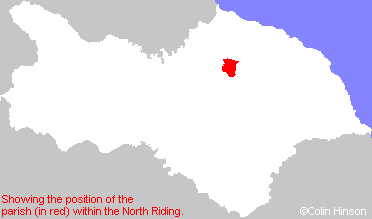

Contents


 |
 |
GenUKI Contents |  |
Yorkshire |
 |
North Riding, Yorkshire |
[Transcribed information mainly from the early 1820s]
"INGLEBY GREENHOW, a parish in the wapentake and liberty of Langbargh; 5 miles, ESE. of Stokesley, a small village, chiefly inhabited by farmers. The church is a small modern structure, re-built in 1741; the living is a perpetual curacy, in the patronage of Sir William Foulis, Bart. of which the Rev. John Dixon is the incumbent. Population, 158."
"BATTERSBY, in the parish of Ingleby Greenhow, wapentake and liberty of Langbargh; 1 mile NE. of Inglegby Greenhow, 5 miles E. of Stokesley. Population, 87."
"GREENHOW, an area in the parish of Ingleby Greenhow, wapentake and liberty of Langbargh; 1¾ miles S. of Ingleby Greenhow, 5 miles SE. of Stokesley. Population, 102."
"INGLEBY MANOR, (the seat of Sir William Foulis, Bart.); in the parish of Ingleby Greenhow, a short distance SSE. from the village of Ingleby Greenhow.
A descendant of Sir David Foulis, Bart. who came into England with James I. was made a Knight in 1603, and created Bart. in 1619. "He was a native was a native of North Britain, and employed by James VI. of Scotland, in several commissions to Queen Elizabeth. He received the honour of Knighthood in 1603, and attending his royal master to Oxford. In 1609 he purchased of Ralph, Lord Eure, Lord President of the Council in Wales, the Manors of Ingleby and Battersby, the Manor-houses, the Parks, with the Rectory and Church of Ingleby, and lands in Ingleby, Battersby, and Greenhow. -For further account, see Graves' Cleveland. In this house was born that eminent historian and divine, Henry Foulis, the second son of Sir Henry Foulis, he was sent to Queen's College, Oxford, and was soon after elected Fellow at Lincoln College, in 1659. He wrote "the History of Wicked Conspiracies, " and "a History of the Romish Treasons and Usurpations." he died Dec. 24, 1669, aged 33 or thereabouts, and was buried in the chancel of St. Michael's Church, Oxon. --ibid. --Wood in his Athenae Oxon, says " the products of his writings shew him to have been a true son of the Church of England.""
